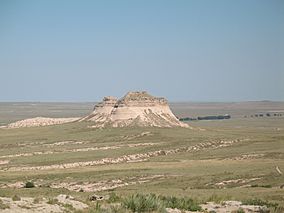Pawnee Buttes facts for kids
Quick facts for kids Pawnee Buttes |
|
|---|---|

Pawnee Buttes and National Grassland
|
|

Map of Colorado with Pawnee National Grasslands highlighted in red
|
|
| Location | Keota, Colorado, Weld County, Colorado, United States |
| Elevation | 1,594 m (5,230 ft) |
| Designated | United States National Grassland |
| Operator | United States Forest Service |
The Pawnee Buttes are two tall, natural rock formations in northeastern Colorado. Imagine them as two giant towers standing alone! The west butte is inside the Pawnee National Grassland. The east butte is on private land nearby in Weld County.
These buttes rise about 300 feet (91 meters) above the flat land around them. They are like leftover pieces of a much higher plain that has slowly worn away over millions of years. The bottom parts of the buttes are made of soft, clay-like rock. This soft rock is protected by a harder layer of sandstone and other rocky bits on top. This harder cap helps the buttes stand tall while the land around them erodes.
Contents
How the Buttes Were Formed
The Pawnee Buttes are located at the edge of an area called the Colorado Piedmont. To the north, this area meets the Chalk Bluffs. These bluffs are like a big cliff at the edge of the High Plains.
Over time, rain and snow slowly wear away the bluffs. This makes the piedmont area grow bigger towards the north. The buttes themselves are like islands of the old High Plains. They are surrounded by the lower piedmont area.
Layers of Rock and Time
The buttes show us different layers of rock from many geological ages. The main part of the butte, the lower half to two-thirds, is a buff-colored layer. This layer comes from the Brule member of the White River Formation. It formed during the Oligocene Epoch, which was about 25 to 40 million years ago.
Above this Brule layer is the Pawnee Creek Formation, which is about 20 million years old. The very top of the buttes is called the Arikaree Formation. This cap rock is a mix of hard sandstone and conglomerate. The Brule layers below are much softer clay. The land around the buttes is sometimes called "badlands." This is because North Pawnee Creek has cut many channels into the soft Brule Formation soils.
Plants and Habitats
The area around the Pawnee Buttes is home to many different plants. These plants grow in special zones based on the soil and how much water is available.
- Short Grass Prairies: These areas surround the buttes. They are mostly covered by short grasses like Blue grama and buffalo grass. You might also see Thread-leaf sedge, ring muhly, and prickly pear cactus here.
- Mixed Prairie: This zone has lighter, sandier soils and is found on higher ground. It has a wider variety of plants. You'll find taller grasses like Needle and thread grass and western wheatgrass. In spring and early summer, colorful forbs (flowering plants) like Broom snakeweed and fringed sage are easy to spot.
- Little Bluestem Pockets: The grass called Little Bluestem grows all over the grasslands. But it really takes over in certain spots. These spots are often in low areas or on north-facing slopes. The shade on these slopes helps the soil hold water longer. Here, you'll also find Canada rye, Phlox, and other grasses and forbs.
- Clay Barrens: These areas are right around the buttes where the Brule Formation rock is exposed. The soil here is very clay-like. Plants with long taproots do well here, like hooker sandwort and tufted milk vetch. Some plants spread using underground stems called rhizomes. Other plants found here include Phlox, Indian rice grass, and evening primrose. Where the land is actively eroding, no plants can grow.
Images for kids
Exploring the Pawnee Buttes Trail
The Pawnee Buttes Trail is famous for its beautiful views and for watching birds. It's a great place to see different kinds of birds.
However, parts of the trail are closed during certain times of the year. The Overlook, the Lipps Bluff trail, and the area within 200 yards (about 183 meters) of the cliffs are closed from March 1 to June 30. This closure helps protect nesting falcons, eagles, and hawks. Hikers are asked to stay away from these areas during this time. This helps keep the nesting birds safe and undisturbed.



